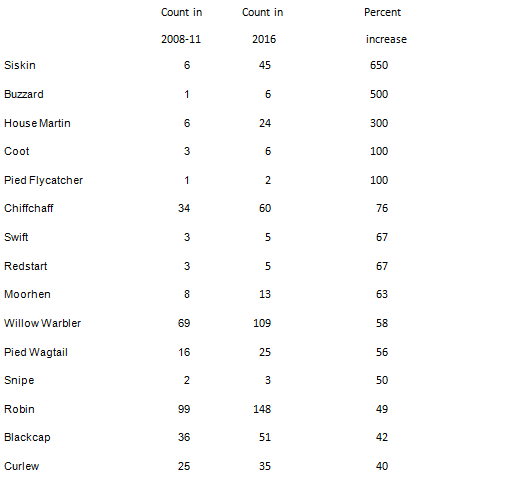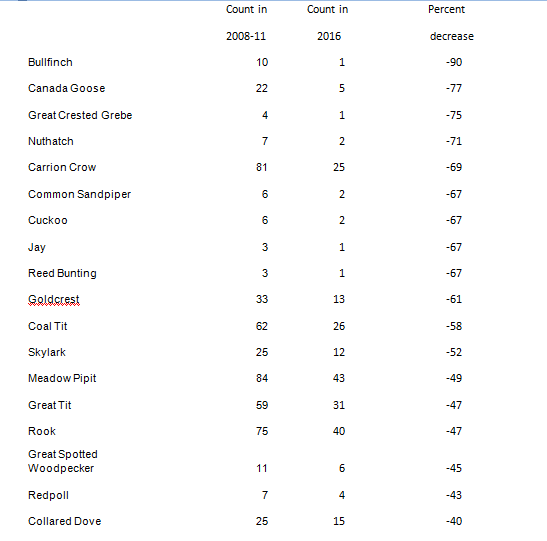Birds Near and Far
Home books dvds apps sites extra maps links contact us blog Buy
Birds Near and Far
Home books dvds apps sites extra maps links contact us blog Buy
A blog by Dave Gosney about some of the birds and places that feature in his books and DVDs but also about the state of birds in the Sheffield area

Breeding birds in SK29 - changes in numbers within this decade
Introduction
In May 2016, I carried out 1-hour bird counts (Timed Tetrad Visits or TTVs) in 24 of the 25 tetrads in SK29. These results have already been compared with similar counts carried out during 1988-90 (here). It wasn't surprising to find that bird numbers had changed over 25 years but could changes have occurred over a much shorter timescale? Here I compare my counts with those made for the BTO during 2008-10 – only 6-8 years previously.
Method
Observers were invited to carry out 1-hour counts of all species during both surveys, in each of the 25 tetrads in SK29. However, one tetrad, SK29 D (Pike Lowe Stones), was not visited during either survey due to its remote location and another tetrad (SK29C) was not visited during 2008-10. Of the remaining 23 tetrads, 9 were not adequately covered during 2008-10 and so are excluded from this analysis. (The excluded tetrads are those in which the number of species found in the 'best' hour was less than 40% of the 'expected' species – based on how many species were found in that tetrad during the 2003-08 SBSG survey when unlimited time was available. In 2016, over 40% of the expected species were found in every tetrad – mean 53%)
Results
Species not found in 2016
In the 14 tetrads being compared, the following 12 species were counted during 'the best' TTVs in 2008-10 but not in 2016. The numbers given show how many were found in 2008-10 followed by the number of tetrads in which they were recorded (during the 'best' 1-hour count only).
Mute Swan (1,1), Tufted Duck (1,1), Goosander (5,1), Kestrel (2,2) Little Owl (1,1), Green Woodpecker (5,4), Stonechat (2,2), Ring Ousel (3,1) Lesser Whitethroat (2,1) Wood Warbler (1,1), Twite (1,1)
In general these species are found in so few tetrads that it's inappropriate to draw any firm conclusion but Twite has almost certainly now disappeared from SK29 and the lack of Green Woodpeckers, Stonechats and Wood Warbler points to a more widely observed decline. The 5 Goosanders were counted on 9th April and could have been malingering winter visitors, not breeders.
'New' species found in 2016
In the 14 tetrads being compared, the following xx species were counted in 2016 but not during the 'best' TTVs in 2008-10. The numbers given show how many were found in 2016 followed by the number of tetrads in which they were recorded.
Cormorant (1,1), Greylag Goose (4,2), Hobby (2,2), Woodcock (1,1), Golden Plover (1,1), Dipper (1,1), Grey Wagtail (4,3), Spotted Flycatcher (4,3), Tree Sparrow (1,1).
In truth, the only genuine newcomer to these tetrads since 2008-10 is the Hobby; all the other species in this list were found in SK29 during the more comprehensive 2003-08 SBSG survey. However, the fact they were recorded during TTVs where previously they had been missed might indicate an increase since 2008-10 at least in the case of Greylag Goose and Spotted Flycatcher. Elsewhere in SK29, but not in the tetrads compared here, Mandarin Duck, Oystercatcher, Tawny Owl and Raven were found during the 2016 TTVs but not the 2008-10 TTVs. Mandarin Duck has recently colonised SK29 and Oystercatcher and Raven have become more widespread.
Species with higher numbers counted in 2016
The following species showed an apparent increase of 40% or more since 2008-10
The figures for Coot, Pied Flycatcher, Swift, Redstart and Snipe are all based on a very small sample size and the 2016 count for House Martin is greatly boosted by one flock of 15 birds which has distorted the picture but the other species could well have increased since 2008-10 or at least been particularly numerous in 2016.
Species with lower numbers counted in 2016
The following species showed an apparent decrease of 40% or more since 2008-10.
This data suggests that the widely-known national declines of Skylark, Cuckoo, Redpoll and, probably, Meadow Pipit have continued locally during the last decade. Lower numbers of Reed Bunting and Common Sandpiper are also in keeping with national trends but the apparent declines shown here of birds such as Great Spotted Woodpecker, Coal Tit, Goldcrest, Carrion Crow, Nuthatch, Canada Goose and, especially, Bullfinch are all rather surprising. They are based on just one count in each period in 14 tetrads only, so they could be just an anomaly caused by sampling error. Or maybe these species are declining for purely local reasons - is something happening to the woodlands in this area? Are the geese suffering more disturbance due to footpaths around the reservoirs? Or maybe these species have only just started to decline and this is being noticed here first.


20th December 2016